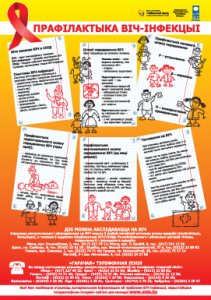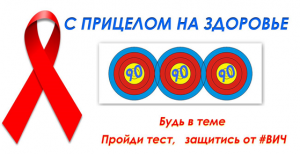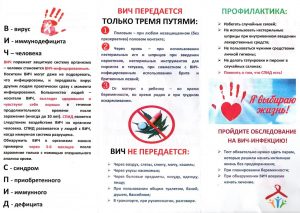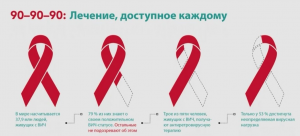World AIDS Day
Annually 1 December is World AIDS Day, adopted in 1988 g. This day is not a public holiday., but for everyone, who is actively fighting the deadly syndrome, this is a very important and serious date. It is dedicated not only to preventive measures, but also the memory of victims of a dangerous disease. Worldwide campaign demonstrates international solidarity in the fight against the HIV epidemic.
AIDS is a progressive viral disease, which makes the body vulnerable to serious infections. For the first time a deadly virus has been reported 5 June 1981 years by scientists from America. Despite, what has passed more 30 years old, so far, no one has managed to defeat the disease. Unfortunately, in many countries AIDS is already epidemic and the only way to protect yourself is to carefully implement all prevention measures.
AIDS is spreading with catastrophic progression and today the number of cases has reached 52 million. people. Immunodeficiency Virus Suffers As Asocial Persons, so those, who became infected due to their own negligence. Most of the sick are the working-age population before 50 years old. The fight against this epidemic is dedicated to World AIDS Day, reminding, that a dangerous disease is always somewhere near.
Initially 1 December, special attention was paid to working with youth and the younger generation. But, as the disease spread throughout the world at an astronomical rate, it was decided to bring as much information as possible to representatives of all ages. After all, as numerous studies have shown, not all adults have an accurate understanding of AIDS and measures to prevent it.
AT 1996 year for the fight against AIDS was organized by the United Nations on HIV / AIDS (UNAIDS), who has been entrusted with the coordination and planning of this special date. Belarus has been a member of the organization since its foundation. UNAIDS office opened in Belarus in 1997 year. UNAIDS Chief Executive Officer - Program Coordinating Board. Our country is a member of the council for the period until 2022 of the year. Beginning with 2018 a special event "Zero Discrimination" is held annually in Minsk, advocating for a human rights-based approach to HIV / AIDS. II European Games in June 2019 g. were held under the motto of a healthy lifestyle, eliminating discrimination and preventing the spread of HIV / AIDS. The most important achievement of the joint efforts of Belarus and UNAIDS was the provision of treatment to all those in need
HIV-infected, preventive treatment for all infected women and children, providing all newborn babies with substitution feeding. Morbidity among young people of age 15-24 years reduced in 2,2 times compared to 2000 year. AT 2016 year Belarus became the first country in the WHO European Region, confirming the exclusion of HIV transmission from mother to child.
On AIDS Day 1 December, thematic seminars are organized, lectures, all kinds of promotions and exhibitions, whose task is to bring to society all the globality and seriousness of the problem. The organizers are charitable foundations, research and scientific centers, social movements. By visiting these events, you can find out the whole truth and myths about the disease, ways of transmission and, most importantly, prevention. Also, the organizers are faced with the task of building loyalty to all AIDS patients., for which the diagnosis should not become a reason to be excluded from society.
Red ribbon has become a symbol of the fight against AIDS, which today can be seen on all information carriers, disease-related. The attribute of understanding and support for all AIDS patients appeared in 1991 year based on a sketch by American artist Frank Moore. This idea came from a man as a result of observing a neighbor's family., who wore yellow ribbons as a symbol of hope for the return of their soldier daughter from the Persian Gulf. Frank Moore suggested, what is such a ribbon, only red, will be able to become a symbol of the fight against the disease and voiced his idea to the group "Visual AIDS", composed of professional artists.
The artist's idea was also approved at the 45th Tony Awards, past 2 June 2000 g. red ribbon, outwardly resembling an inverted English letter "V", has become an official symbol of the fight against AIDS. All those present at the event put on this memorable attribute., launching a worldwide action of memory and confrontation. The laconic red ribbon quickly gained its popularity., not only wear it 1 December, but also at all events, where AIDS is relevant.
AT 2020 year, the world's attention is focused on the COVID-19 pandemic and its impact on the lives and well-being of people. This pandemic has shown us once again, how closely the health issue is linked to other important issues, such as human rights, gender equality and social protection. COVID-19 has clearly demonstrated, that in any pandemic, the safety of everyone depends on the safety of everyone. To achieve success, need to help everyone, who needs her. Eliminating stigma and discrimination, and application of approaches, based on human rights and gender equality, - these are the main conditions for ending the HIV and COVID-19 pandemics in the world.
World AIDS Day remains relevant today, recalling that, that raising HIV awareness remains critical.
 Motto 2020 of the Year - International Solidarity, shared responsibility ", which is confirmed by the participation in the preventive work of state, public and international organizations. The main goal of the activities is to acquire reliable knowledge on all aspects of HIV infection and increase the level of tolerant attitude towards people., living with HIV.
Motto 2020 of the Year - International Solidarity, shared responsibility ", which is confirmed by the participation in the preventive work of state, public and international organizations. The main goal of the activities is to acquire reliable knowledge on all aspects of HIV infection and increase the level of tolerant attitude towards people., living with HIV.
According to statistics from the World Health Organization, there are more than 38 million HIV positive people. About 23 thousands of people. More than 2 thousand new cases of HIV infection. In the country in recent years, the largest number of new cases is registered at the age of 30 to 49 years old. Heterosexual transmission of HIV prevails, which is over 80%.
A system has been created in the Republic of Belarus, ensuring maximum accessibility to counseling and testing
for HIV infection. Take voluntary testing
for HIV infection, including anonymous, possible in any medical institution, having a treatment room. Also in the country, on the basis of public non-profit organizations, there are anonymous consulting centers., providing HIV counseling and testing services to key populations (of people, affected by drug addiction; youth, practicing risky sexual behavior; workers, sex workers for a fee; men, practicing sex with men).
All HIV-positive patients in the Republic of Belarus, dispensary, receive antiretroviral therapy drugs free of charge. Starting treatment on time and following all the doctor's recommendations, people, living with HIV, can live long and fulfilling lives. The quality of life of HIV-positive people, thanks to these drugs, is almost the same as the quality of life of people without HIV.
The efforts of the medical community, education system, of culture, mass media are aimed at educating the population on the prevention of HIV infection, with an emphasis on maintaining the social value of the family and the birth of a healthy generation, respect for human rights, avoiding stigma and discrimination against people, living with HIV.
For the World HIV / AIDS Campaign in November
2020 year in Minsk in the cinema "Dom Kino" a republican exhibition of prize-winners of graphic works on the topic "Formation of a tolerant attitude towards people, living with HIV. Overcoming stigma and non-discrimination ". Only in a tolerant and enlightened society can mechanisms for controlling the spread of
HIV infection. Eliminating stigma and non-discrimination against people, living with HIV, allows you to create conditions for timely seeking help and treatment, to change behavior; reduce unfounded fears and normalize relationships between people; break down the psychological barrier, discouraging HIV testing.
WITH 20 November to 24 December 2020 g. the republican preventive action “With an eye to health: 90-90-90. Be in the subject. Take the test. Protect yourself from #HIV ".

During the campaign, everyone can voluntarily undergo rapid HIV testing using saliva., get advice from an epidemiologist and a psychologist on issues, related to HIV infection, as well as outreach materials, personal protective equipment (condoms).
What you need to know about HIV infection?
HIV infection. Risk factors, prevention
HIV infection is a slowly progressive infectious disease, arising from infection with the human immunodeficiency virus (HIV), damaging the immune system, as a result of which the body becomes highly susceptible to opportunistic infections and tumors, which ultimately lead to the death of the patient. AIDS (acquired immunodeficiency syndrome) - the final stage of the development of HIV infection.

Source of infection. Transmission routes.
The source of infection is an HIV-infected person at all stages of the disease.
Exists 3 HIV transmission routes:
– contact (sexual);
– parenteral (through blood, syringes, needles, cutting tools, etc., contaminated with blood, containing HIV);
– vertical (from mother to fetus).
- Sexual transmission of HIV.
There is a risk of HIV transmission in all types of sex.. Every sexual intercourse without protection (without a condom) with an HIV-infected person puts the sexual partner at risk. Sexual Infection Risk Increases, if the sexual partner is an injection drug user, has many sexual partners, practicing homo- or bisexual relationships. Women are usually more vulnerable to HIV infection. Transmission of the virus from a man to a woman is about twice as likely, than from a woman to a man. In terms of infection, HIV-infected people are more dangerous to others at the earliest stages - before the appearance of antibodies in the blood., ie. during the "seroconversion window", and in the later stages of the disease, when there are clinical manifestations of AIDS. During these periods, the content of the virus in the blood and other biological media is much higher., than at other times. Presence of infections, sexually transmitted, increases the risk of infection in 6-9 time. Contact with STI pathogens causes inflammation; Besides, many STIs (syphilis, herpes, etc.) cause ulceration in the genital area, which greatly facilitates the penetration of the virus.
- Transmission of HIV through blood.
An infected person's blood contains a large amount of the virus and is extremely infectious if it enters another person's bloodstream directly. There is a risk of infection through transfusion of contaminated donor blood. This route is significant among injecting drug users.. As a result, sharing needles and syringes by injecting drug users has become a major contributor to the spread of HIV infection in many countries. There is a small risk of the virus penetrating through invisible microtrauma and cracks during prolonged contact of blood with skin. There is also a danger of virus penetration through the mucous membranes., eg, if blood gets into the eyes or mouth. Intact skin is a good barrier to the virus. Infection through a razor blade contaminated with blood is also possible., manicure supplies, tattoo tools.
- Mother-to-child transmission (vertical path).
There are three periods, during which an infected mother can transmit the virus to her baby:
- during pregnancy (before birth);
- during childbirth;
- after birth, when breastfeeding.
Fetal infection occurs when, if mother is infected.
Risk factors: addiction, asocial lifestyle, blood transfusion, being born to an HIV-infected mother, diseases with venereal diseases.
The structure of HIV-infected is dominated by persons aged 20-29 years old, and the proportion of males is about 70 %.
How HIV is not transmitted
The emergence of HIV infection, the lack of any effective drugs for its treatment has caused a huge number of rumors and speculations about the ways of HIV transmission. However, as a result of many years of observation of numerous household contacts
HIV-infected was found, that HIV is not transmitted:
with friendly hugs and kisses;
through handshakes;
when using cutlery, bedding;
through items of industrial and home furnishings;
through plumbing items, when using the pool, shower;
in public transport;
insects, including bloodsucking;
by airborne droplets.
Properties of HIV
Human Immunodeficiency Virus is an unstable virus:
- dies under the direct influence of alcohol, acetone, ether;
- on the surface of intact skin, the virus is destroyed under the influence of protective enzymes of the body and bacteria;
- dies when heated above 57 ° С during 30 minutes;
- dies when boiled for 1 minutes.
The virus is constantly changing, falling from one person to another, changes even during treatment. Therefore, it is difficult to create a vaccine and drugs against HIV..
Development of HIV infection
The body's primary reaction to the introduction of HIV is manifested by the production of antibodies. From the moment of infection to the development of antibodies, it usually takes an average of 3 weeks before 3 months. It is not uncommon for antibodies to appear only after 6 months. This period is called the "seroconversion window" period..

The next period of HIV development is called asymptomatic or latent. Its duration may be different.: from several months to several years (5-15 years old). It is characterized by the absence of manifestations of the disease.. After an asymptomatic period, an infectious process may develop in the body.. Among the first signs of disease progression is an enlarged lymph node. (lymphadenopathy).
When HIV progresses to AIDS, a person may have these symptoms:
weight loss;
malaise, fatigue, drowsiness;
loss of appetite;
unmotivated diarrhea (diarrhea);
temperature increase;
headache;
swollen lymph nodes.
AIDS is characterized by the development of opportunistic (accompanying) infections and tumors. Infections are difficult to treat.
HIV can be influenced with antiretroviral drugs (ARV) drugs, which slow down the progression of HIV infection to the point of preventing the development of AIDS. The result of antiretroviral therapy is a significant lengthening of life expectancy and an improvement in its quality..
Diagnosis of HIV infection
It is impossible to determine the presence of HIV in the body and to diagnose only by external signs.. Blood test required. At the same time, the fact of the presence of antibodies to HIV in the blood is established. (HIV test) and the amount of the virus itself (viral load).
Linked immunosorbent assay (ELISA) carried out to detect antibodies to HIV in the blood serum.
Polymerase chain reaction method (PCR) used to determine viral load. This is a very effective and sensitive response., allowing to determine the presence of the virus regardless of the presence of antibodies.
Besides, rapid HIV tests are currently in use, which allow you to get the result through 15-30 minutes.
HIV testing can be done in all health care organizations in the republic.. Before the examination, pre-test counseling is carried out, during which they inform about further actions depending on the result. After receiving the test result, post-test counseling is carried out. In case of a positive result, it is, first of all, providing information about the disease and emotional support of a person. If the result is negative, questions are discussed with the person, associated with the prevention of the risk of HIV infection in the future.
Prevention of HIV infection
In the Republic of Belarus in accordance with the subprogram 5 "Prevention of HIV infection" of the state program "People's health and demographic security" 2016-2020 years, an Information Strategy on HIV Infection was developed. The new edition of the information strategy on HIV infection in Belarus is designed for 2019-2023 the years. State and international organizations participated in its development.
The main directions of HIV prevention:
safe sexual behavior, condom use; treatment of other diseases, sexually transmitted;
formation in persons, injecting drug users, safer behavior skills, providing them with means of protection (sterile syringes, condoms);
an absolutely reliable means of protection against HIV infection is a complete cessation of drug use;
ensuring aseptic conditions in medical practice;
organization of medical care and social support for HIV-infected patients, their families and others.
A healthy lifestyle is closely related to a person's awareness of the patterns of development of the body, knowledge of, what is useful for him, and what can harm.
Healthy lifestyle, taking care of your health and the health of your loved ones is the basis of HIV prevention.
(Based on materials from the websites of the Republican Hygiene Center, Epidemiology and Public Health a set of graphic and information materials://rcheph.by/news/vsemirnyy-den-borby-so-spidom.html, Ministry of Foreign Affairs of Belarus a set of graphic and information materials://mfa.gov.by/mulateral/organization/list/c886c0574dfe12f3.html;
Institute of Parliamentarism and Entrepreneurship a set of graphic and information materials://ipp.by/ideologicheskaya-rabota/profilakticheskaya-rabota/profilaktika-vich-infektsii; ME "City infectious diseases hospital" a set of graphic and information materials://gkib.by/obrashcheniya/571-konsultativnaya-pomoshch-po-voprosam-vich-spid-telefony-goryachikh-linij-dlya-molodezhi)
HIV / AIDS Counseling
HOT LINE PHONES FOR YOUTH
IN THE DEPARTMENTS OF HIV / AIDS PREVENTION OF REGIONAL HYGIENE CENTERS, EPIDEMIOLOGY AND PUBLIC HEALTH
g. Minsk - tel. (8 017) 227 48 25
g. Vitebsk - tel. (8 0212) 223 80 82
g. Gomel - tel. (8 0232) 74 71 40
g. Mogilev - tel. (8 0222) 24 27 06, 27 08 26
CONSULTATIVE ASSISTANCE ON HIV / AIDS, DRUG ADDICTION, INFECTIONS, SEXUALLY TRANSMITTED:
Minsk City Narcological Dispensary: st. Gastello, 16, wire. (8 017) 203 56 98, 235 14 01;
Minsk Regional Psychoneurological Dispensary: st. Ponomarenko,5,
wire. (8 017) 251 41 70, 207 68 18;
Brest Regional Narcological Dispensary: st. 17 September, 20, wire. (8 0162) 26 52 51;
Vitebsk Regional Psychoneurological Dispensary: st. Gagarin, 10AND,
wire. (8 0212) 24 98 91, 24 66 90, 24 63 10;
Gomel Regional Narcological Dispensary: st. D. Poor, 26,
wire. (8 0232)55 92 51, 55 96 32;
Grodno Regional Narcological Dispensary: Ave. Kosmonavtov, 60/6,
wire. (8 0152) 75 67 48, 75 67 60;
Mogilev Regional Narcological Dispensary: st. Surganova, 41, wire. (8 0222) 27 92 83.
Republican Center of Hygiene, Epidemiology and Public Health
HIV / AIDS Prevention Department (220048 g. Minsk, st. TO. Cetkin, 4 (3-th floor)
Procedural phone (anonymous) HIV testing room, syphilis, hepatitis B and C (HIV testing at will - anonymously):
(8 017) 321 22 68.
AIDS Prevention Departments of the Regional CGiE and Public Health:
g. Brest, wire. (8 0162) 23 67 00;
g. Gomel, wire. (8 0232) 74 71 40;
g. Mogilev, wire. (8 0222) 24 27 07;
g. Grodno, wire. (8 0152) 75 57 48, 75 54 14;
g. Vitebsk, wire. 21 00 21.
Minsk City Dermatovenerologic Dispensary:
st. Прилукская, 46-and, wire. (8 017) 270 91 14, 270 91 01;
Minsk Regional Skin and Venereal Diseases Dispensary:
st. P. Eyebrows, 7, wire. (8 017) 233 97 04, 232 31 02;
Brest Regional Skin and Venereal Diseases Dispensary:
st. Medical, 5, d. Stockings of the Brest region, wire. (8 0162) 97 70 22;
Vitebsk Regional Skin and Venereal Diseases Dispensary:
st. B. Khmelnitsky, 9, wire. (8 0212) 27 10 73, 37 38 62;
Gomel Regional Skin and Venereal Diseases Dispensary:
st. Medical, 10, wire. (8 0232) 45 88 97, 45 95 57;
Grodno Regional Skin and Venereal Disease Dispensary:
st. Dombrovsky, 39AND, wire. (8 0152) 39 02 94, 78 23 84;
Mogilev Regional Skin and Venereal Diseases Dispensary:
inl. Pine, 4, wire. (8 0222) 42 89 61, 42 14 16.
